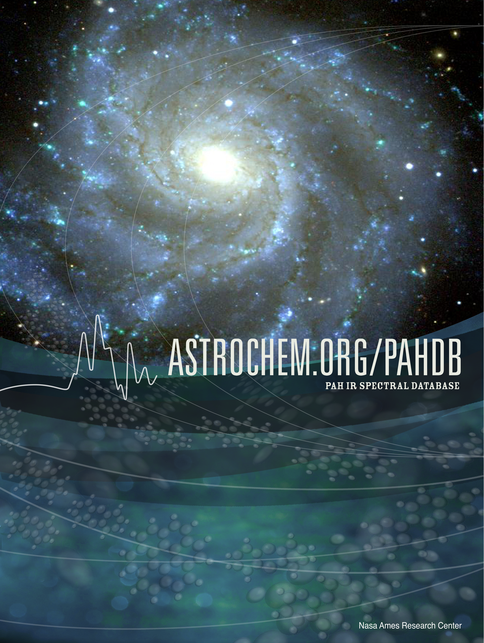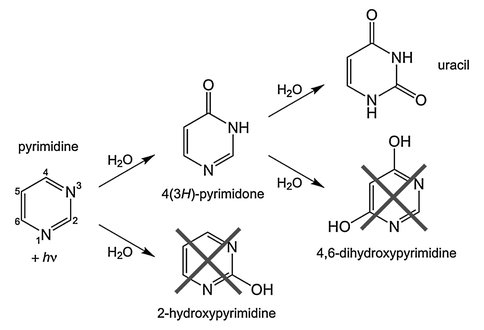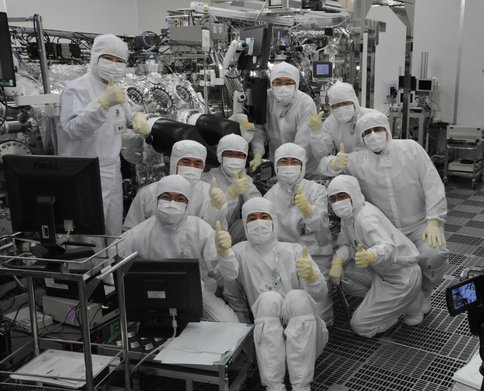2010 Annual Science Report
 NASA Ames Research Center
Reporting | SEP 2009 – AUG 2010
NASA Ames Research Center
Reporting | SEP 2009 – AUG 2010
Cosmic Distribution of Chemical Complexity
Project Summary
This project is aimed to improve our understanding of the connection between chemistry in space and the origin of life on Earth, and its possibility on other worlds. Our approach is to trace the formation and development of chemical complexity in space, with particular emphasis on understanding the evolution from simple to complex species. The work focuses upon molecular species that are interesting from a biogenic perspective and also upon understanding their possible roles in the origin of life on habitable worlds. We do this by first measuring the spectra and chemistry of materials under simulated space conditions in the laboratory. We then use these results to interpret astronomical observations made with ground-based and orbiting telescopes. We also carry out experiments on simulated extraterrestrial materials to analyze extraterrestrial samples returned by NASA missions or that fall to Earth in meteorites.
Project Progress
(1) In August 2010, we put on the web our collection of more than 600 polycyclic aromatic hydrocarbon (PAH) spectra together with the tools needed to query the data and analyze astronomical spectra (Figure 1). Three PAH-related papers were published to support missions such as Spitzer, SOFIA, Herschel, and JWST. Two other papers were published that describe a detailed lab study of the photochemical kinetics of several PAHs in cosmic ice analogs, providing the first solid state reaction rates needed to model extraterrestrial ice chemistry from the Solar System to the ISM. This novel modeling capability opens a new field of study.
Figure 1.. Poster announcing the NASA Ames PAH IR Spectroscopic Database and web site.
(2) We have published one paper and are working on others that describe the production of prebiotic compounds by UV irradiation of cosmic ices. The published paper appeared in Astrobiology and described work showing the photolysis of pyrimidine in H2O ices produces a host of new compounds, including the nucleobase uracil (Figure 2). A second paper in preparation shows that the addition of ammonia to the ice results in the production of the nucleobase cytosine.
Figure 2.. Irradiation of pyrimidine in H2O-rich ices results in the production of many new molecules, including the nucleobase uracil.
(3) Mission involvement- Co-I Sandford continues to be involved with the extraction, distribution, and analysis of samples from Comet 81P/Wild 2 returned by the Stardust mission (two related papers in the last year). He also continues to work as a Co-I on the Hayabusa asteroid sample return mission, which returned samples to Earth in June 2010 and is now actively studying these samples (Figure 3). Andrew Mattioda is a member of the Science Team for the O/OREOS (Organisms/ORganics Exposure to Orbital Stresses), NASA’s first Astrobiology Small Payloads mission. He and Nathan Bramall are working on the SEVO (Space Environment Viability of Organics) component for O/OREOS.
Figure 3.. Co-I Dr. Scott Sandford with the team that opened the Hayabusa sample return capsule (he is the person in the cleanroom suit to the farthest right)
This year Pascale Ehrenfreund (Wisconsin team), in collaboration with Co-Is Allamandola and Mattioda was awarded an NAI DDF grant to investigate the modification of organic materials (particularly PAHs) under interstellar conditions via UV-Visible spectroscopy. This DDF employs post-doctoral researcher Kathryn Bryson, who has set up the UV-Vis spectrometer system and has begun a spectroscopic study of thin films of astrobiologically interesting organic molecules.
Publications
-
Bajt, S., Sandford, S. A., Flynn, G. J., Matrajt, G., Snead, C. J., Westphal, A. J., & Bradley, J. P. (2009). Infrared spectroscopy of Wild 2 particle hypervelocity tracks in Stardust aerogel: Evidence for the presence of volatile organics in cometary dust. Meteoritics & Planetary Science, 44(4), 471–484. doi:10.1111/j.1945-5100.2009.tb00745.x
-
Bauschlicher, C. W., Boersma, C., Ricca, A., Mattioda, A. L., Cami, J., Peeters, E., … Allamandola, L. J. (2010). THE NASA AMES POLYCYCLIC AROMATIC HYDROCARBON INFRARED SPECTROSCOPIC DATABASE: THE COMPUTED SPECTRA. The Astrophysical Journal Supplement Series, 189(2), 341–351. doi:10.1088/0067-0049/189/2/341
-
Bera, P. P., Nuevo, M., Milam, S. N., Sandford, S. A., & Lee, T. J. (2010). Mechanism for the abiotic synthesis of uracil via UV-induced oxidation of pyrimidine in pure H[sub 2]O ices under astrophysical conditions. J. Chem. Phys., 133(10), 104303. doi:10.1063/1.3478524
-
Bouwman, J., Cuppen, H. M., Bakker, A., Allamandola, L. J., & Linnartz, H. (2010). Photochemistry of the PAH pyrene in water ice: the case for ion-mediated solid-state astrochemistry. A&A, 511, A33. doi:10.1051/0004-6361/200913291
-
Clemett, S. J., Sandford, S. A., Nakamura-Messenger, K., HÖRZ, F., & McKAY, D. S. (2010). Complex aromatic hydrocarbons in Stardust samples collected from comet 81P/Wild 2. Meteoritics & Planetary Science, 45(5), 701–722. doi:10.1111/j.1945-5100.2010.01062.x
-
Nuevo, M., Milam, S. N., Sandford, S. A., Elsila, J. E., & Dworkin, J. P. (2009). Formation of Uracil from the Ultraviolet Photo-Irradiation of Pyrimidine in Pure H 2 O Ices. Astrobiology, 9(7), 683–695. doi:10.1089/ast.2008.0324
-
Ricca, A., Bauschlicher, C. W., Mattioda, A. L., Boersma, C., & Allamandola, L. J. (2009). THE FAR-INFRARED SPECTROSCOPY OF VERY LARGE NEUTRAL POLYCYCLIC AROMATIC HYDROCARBONS. The Astrophysical Journal, 709(1), 42–52. doi:10.1088/0004-637x/709/1/42
-
Roser, J. E., & Allamandola, L. J. (2010). INFRARED SPECTROSCOPY OF NAPHTHALENE AGGREGATION AND CLUSTER FORMATION IN ARGON MATRICES. The Astrophysical Journal, 722(2), 1932–1938. doi:10.1088/0004-637x/722/2/1932
-
Sandford, S. A., Bajt, S., Clemett, S. J., Cody, G. D., Cooper, G., Degregorio, B. T., … Zolensky, M. E. (2010). Assessment and control of organic and other contaminants associated with the Stardust sample return from comet 81P/Wild 2. Meteoritics & Planetary Science, 45(3), 406–433. doi:10.1111/j.1945-5100.2010.01031.x
-
Spencer, M. K., Clemett, S. J., Sandford, S. A., McKAY, D. S., & Zare, R. N. (2009). Organic compound alteration during hypervelocity collection of carbonaceous materials in aerogel. Meteoritics & Planetary Science, 44(1), 15–24. doi:10.1111/j.1945-5100.2009.tb00714.x
-
Wirick, S., Flynn, G. J., Keller, L. P., Nakamura-Messenger, K., Peltzer, C., Jacobsen, C., … Zolensky, M. (2009). Organic matter from comet 81P/Wild 2, IDPs, and carbonaceous meteorites; similarities and differences. Meteoritics & Planetary Science, 44(10), 1611–1626. doi:10.1111/j.1945-5100.2009.tb01194.x
- Sandford, S.A. (2009). Organics in the Samples Returned by the Stardust Spacecraft from Comet 81P/Wild 2. In: Meech, K.J., Keane, J.V., Mumma, M.J., Siefert, J.L. & Werthimer, D.J. (Eds.). Bioastronomy 2007 – Molecules, Microbes, and Extraterrestrial Life. Vol. 421. Astronomical Society of the Pacific Conference Series.
-
PROJECT INVESTIGATORS:
-
PROJECT MEMBERS:
Murthy Gudipati
Co-Investigator
Andrew Mattioda
Co-Investigator
Scott Sandford
Co-Investigator
Max Bernstein
Collaborator
Jan Cami
Collaborator
Jamie Cook
Collaborator
Jason Dworkin
Collaborator
Els Peeters
Collaborator
Christiaan Boersma
Postdoc
Nathan Bramall
Postdoc
Michel Nuevo
Postdoc
Joseph Roser
Postdoc
-
RELATED OBJECTIVES:
Objective 1.1
Formation and evolution of habitable planets.
Objective 2.1
Mars exploration.
Objective 2.2
Outer Solar System exploration
Objective 3.1
Sources of prebiotic materials and catalysts
Objective 3.2
Origins and evolution of functional biomolecules
Objective 3.4
Origins of cellularity and protobiological systems
Objective 4.3
Effects of extraterrestrial events upon the biosphere
Objective 7.1
Biosignatures to be sought in Solar System materials
Objective 7.2
Biosignatures to be sought in nearby planetary systems



